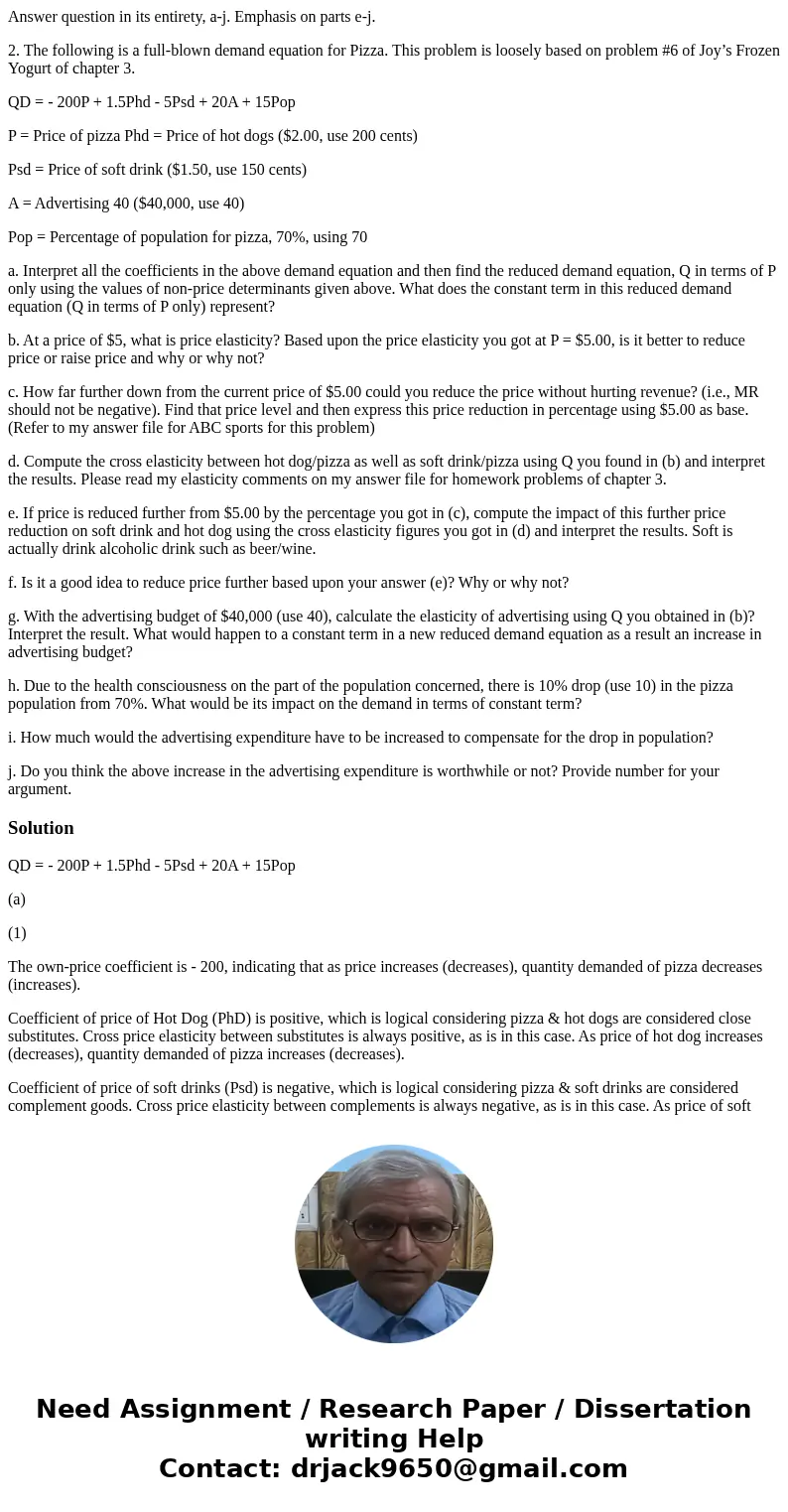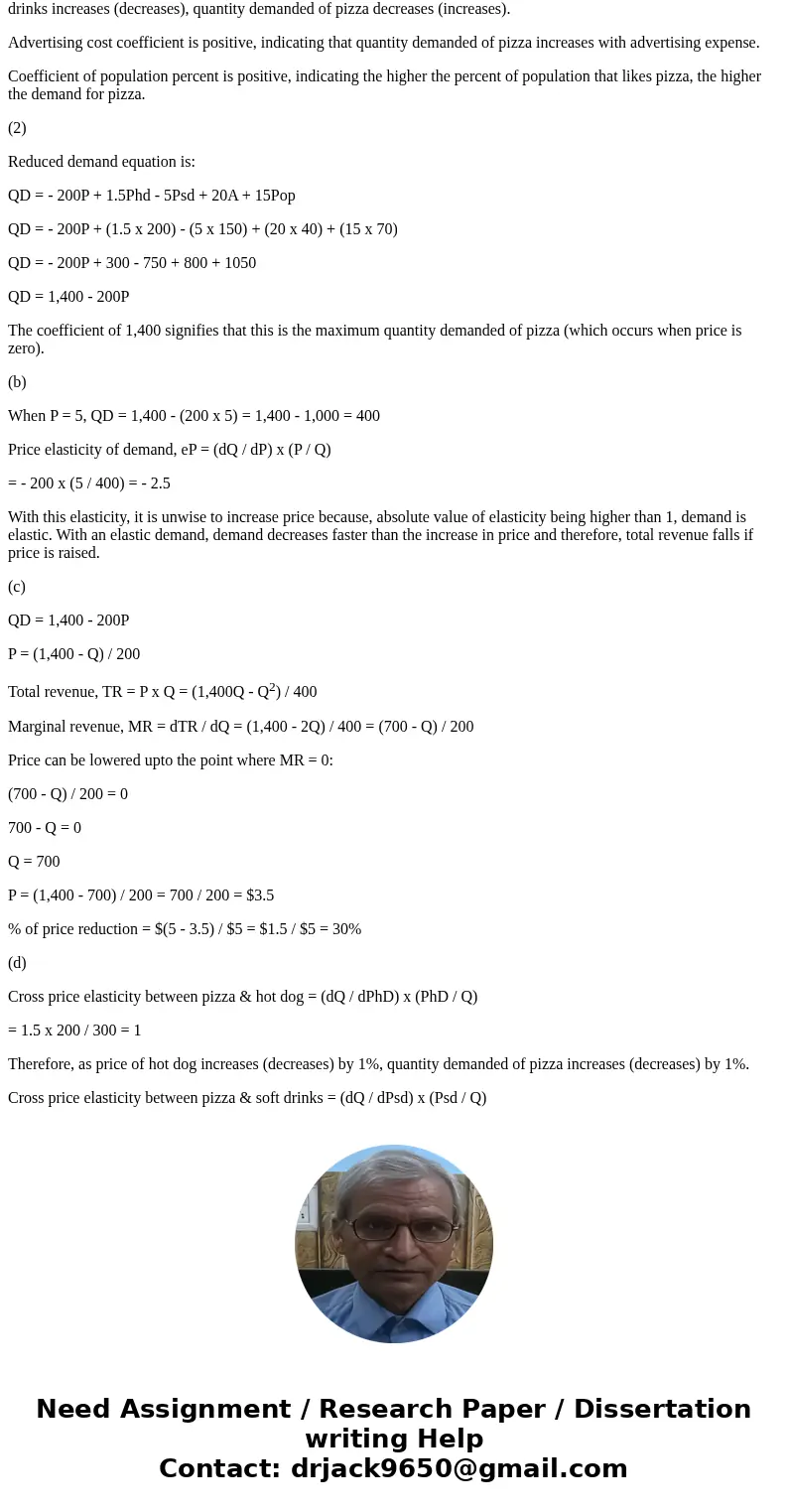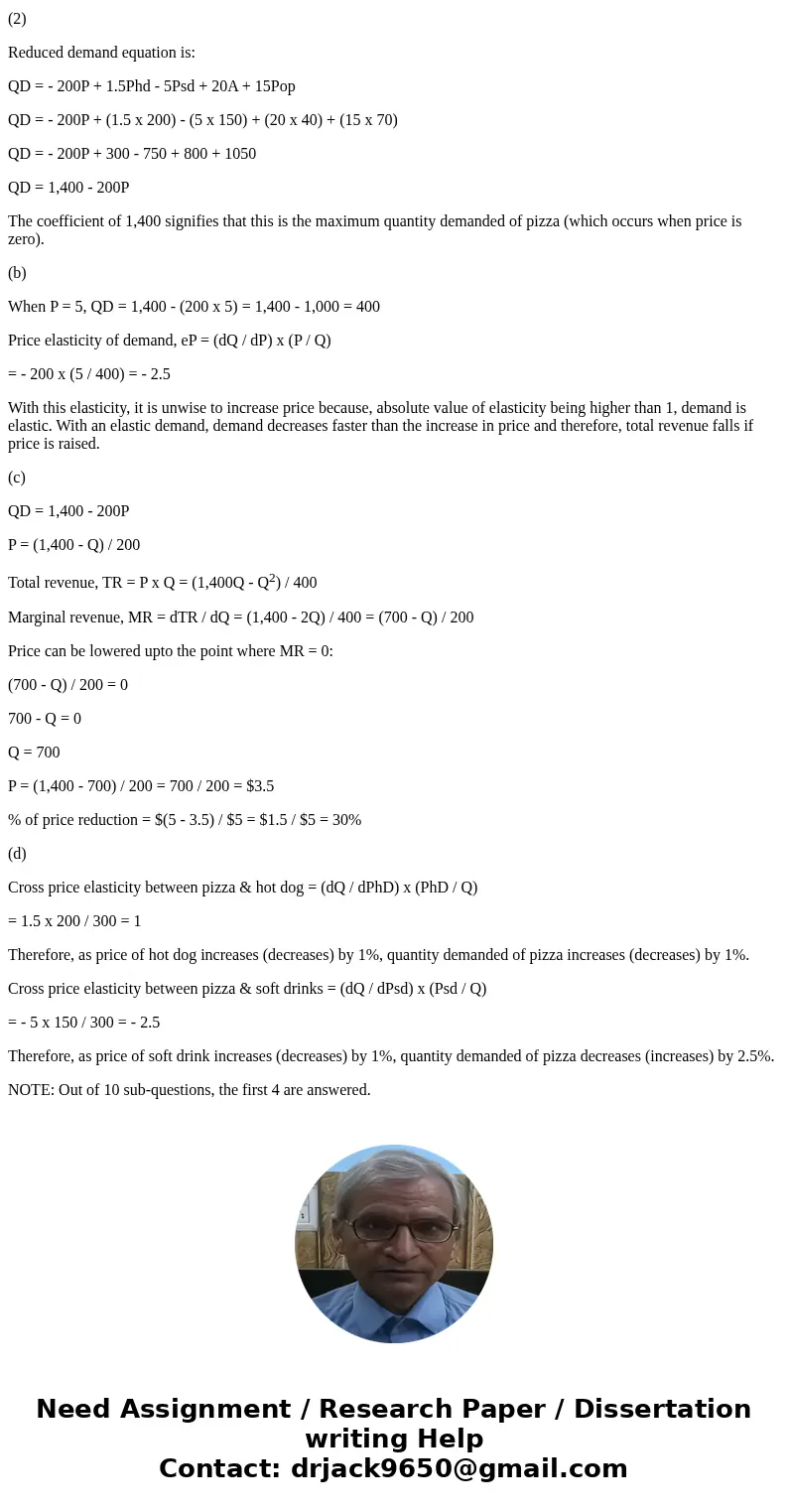Answer question in its entirety aj Emphasis on parts ej 2 Th
Answer question in its entirety, a-j. Emphasis on parts e-j.
2. The following is a full-blown demand equation for Pizza. This problem is loosely based on problem #6 of Joy’s Frozen Yogurt of chapter 3.
QD = - 200P + 1.5Phd - 5Psd + 20A + 15Pop
P = Price of pizza Phd = Price of hot dogs ($2.00, use 200 cents)
Psd = Price of soft drink ($1.50, use 150 cents)
A = Advertising 40 ($40,000, use 40)
Pop = Percentage of population for pizza, 70%, using 70
a. Interpret all the coefficients in the above demand equation and then find the reduced demand equation, Q in terms of P only using the values of non-price determinants given above. What does the constant term in this reduced demand equation (Q in terms of P only) represent?
b. At a price of $5, what is price elasticity? Based upon the price elasticity you got at P = $5.00, is it better to reduce price or raise price and why or why not?
c. How far further down from the current price of $5.00 could you reduce the price without hurting revenue? (i.e., MR should not be negative). Find that price level and then express this price reduction in percentage using $5.00 as base. (Refer to my answer file for ABC sports for this problem)
d. Compute the cross elasticity between hot dog/pizza as well as soft drink/pizza using Q you found in (b) and interpret the results. Please read my elasticity comments on my answer file for homework problems of chapter 3.
e. If price is reduced further from $5.00 by the percentage you got in (c), compute the impact of this further price reduction on soft drink and hot dog using the cross elasticity figures you got in (d) and interpret the results. Soft is actually drink alcoholic drink such as beer/wine.
f. Is it a good idea to reduce price further based upon your answer (e)? Why or why not?
g. With the advertising budget of $40,000 (use 40), calculate the elasticity of advertising using Q you obtained in (b)? Interpret the result. What would happen to a constant term in a new reduced demand equation as a result an increase in advertising budget?
h. Due to the health consciousness on the part of the population concerned, there is 10% drop (use 10) in the pizza population from 70%. What would be its impact on the demand in terms of constant term?
i. How much would the advertising expenditure have to be increased to compensate for the drop in population?
j. Do you think the above increase in the advertising expenditure is worthwhile or not? Provide number for your argument.
Solution
QD = - 200P + 1.5Phd - 5Psd + 20A + 15Pop
(a)
(1)
The own-price coefficient is - 200, indicating that as price increases (decreases), quantity demanded of pizza decreases (increases).
Coefficient of price of Hot Dog (PhD) is positive, which is logical considering pizza & hot dogs are considered close substitutes. Cross price elasticity between substitutes is always positive, as is in this case. As price of hot dog increases (decreases), quantity demanded of pizza increases (decreases).
Coefficient of price of soft drinks (Psd) is negative, which is logical considering pizza & soft drinks are considered complement goods. Cross price elasticity between complements is always negative, as is in this case. As price of soft drinks increases (decreases), quantity demanded of pizza decreases (increases).
Advertising cost coefficient is positive, indicating that quantity demanded of pizza increases with advertising expense.
Coefficient of population percent is positive, indicating the higher the percent of population that likes pizza, the higher the demand for pizza.
(2)
Reduced demand equation is:
QD = - 200P + 1.5Phd - 5Psd + 20A + 15Pop
QD = - 200P + (1.5 x 200) - (5 x 150) + (20 x 40) + (15 x 70)
QD = - 200P + 300 - 750 + 800 + 1050
QD = 1,400 - 200P
The coefficient of 1,400 signifies that this is the maximum quantity demanded of pizza (which occurs when price is zero).
(b)
When P = 5, QD = 1,400 - (200 x 5) = 1,400 - 1,000 = 400
Price elasticity of demand, eP = (dQ / dP) x (P / Q)
= - 200 x (5 / 400) = - 2.5
With this elasticity, it is unwise to increase price because, absolute value of elasticity being higher than 1, demand is elastic. With an elastic demand, demand decreases faster than the increase in price and therefore, total revenue falls if price is raised.
(c)
QD = 1,400 - 200P
P = (1,400 - Q) / 200
Total revenue, TR = P x Q = (1,400Q - Q2) / 400
Marginal revenue, MR = dTR / dQ = (1,400 - 2Q) / 400 = (700 - Q) / 200
Price can be lowered upto the point where MR = 0:
(700 - Q) / 200 = 0
700 - Q = 0
Q = 700
P = (1,400 - 700) / 200 = 700 / 200 = $3.5
% of price reduction = $(5 - 3.5) / $5 = $1.5 / $5 = 30%
(d)
Cross price elasticity between pizza & hot dog = (dQ / dPhD) x (PhD / Q)
= 1.5 x 200 / 300 = 1
Therefore, as price of hot dog increases (decreases) by 1%, quantity demanded of pizza increases (decreases) by 1%.
Cross price elasticity between pizza & soft drinks = (dQ / dPsd) x (Psd / Q)
= - 5 x 150 / 300 = - 2.5
Therefore, as price of soft drink increases (decreases) by 1%, quantity demanded of pizza decreases (increases) by 2.5%.
NOTE: Out of 10 sub-questions, the first 4 are answered.



 Homework Sourse
Homework Sourse